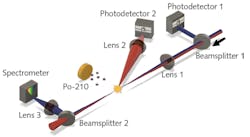Remote Sensing: Radioactive material detected remotely using laser-induced electron avalanche breakdown
Physicists at the University of Maryland (UMD; College Park, MD) have developed a new laser-based method to remotely detect radioactive material.1 Based on using an infrared (IR) laser beam to induce an electron avalanche breakdown near the material, the new technique is able to detect shielded material from a distance. A mid-IR (3.9 μm) laser induces avalanche breakdown in air, which is sensitive to “seed” ionization produced by radioactivity. The method improves upon current technologies that require close proximity to the radioactive material.
In the simplest version, the result is an on-off detection sensitivity. The researchers have also developed a more-sophisticated version that measures the shift of the temporal onset of avalanche and relates that to the degree of ionization from the radioactive source.
“Traditional detection methods rely on a radioactive-decay particle interacting directly with a detector,” says Robert Schwartz, a physics graduate student at UMD. “All of these methods decline in sensitivity with distance. The benefit of our method is that it is inherently a remote process. With further development, it could detect radioactive material inside a box from the length of a football field.”
As radioactive material emits decay particles, the particles strip electrons from nearby atoms in the air, creating a small number of free electrons that quickly attach to oxygen molecules. By focusing the mid-IR laser beam into this area, Schwartz and his colleagues easily detached these electrons from their oxygen molecules, seeding an avalanche breakdown, which is relatively easy to detect (see figure).
Method is scalable
The researchers note that their method is highly specific and sensitive to the detection of radioactive material. Without a laser pulse, radioactive material alone will not induce an electron avalanche. Similarly, a laser pulse alone will not induce an avalanche without the seed electrons created by the radioactive material.
While the method remains a proof-of-concept exercise for now, the new method to detect radioactive material could be scaled up to scan shipping containers at ports of entry, providing a new tool for security applications.
“Right now, we’re working with a lab-sized laser, but in 10 years or so, engineers may be able to fit a system like this inside a van,” Schwartz says. “Anywhere you can park a truck, you can deploy such a system. This would provide a very powerful tool to monitor activity at ports.”
REFERENCE
1. R. M. Schwartz et al., Sci. Adv. (2019); doi:10.1126/sciadv.aav6804.

John Wallace | Senior Technical Editor (1998-2022)
John Wallace was with Laser Focus World for nearly 25 years, retiring in late June 2022. He obtained a bachelor's degree in mechanical engineering and physics at Rutgers University and a master's in optical engineering at the University of Rochester. Before becoming an editor, John worked as an engineer at RCA, Exxon, Eastman Kodak, and GCA Corporation.
